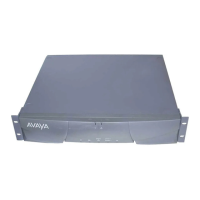GPTD-PT (General-Purpose Tone Detector Port)
Issue 1 May 2002
8-883555-233-143
GPTD-PT (General-Purpose Tone
Detector Port)
The GPTD (General-Purpose Tone Detector) ports, also known as CPTRs
(Call-Progress Tone Receivers), reside on the following circuit packs:
■ TN748 all suffixes (mu-law companding)
The GPTD port performs level measurements of test tones and to detect
call-progress tones. Examples of call-progress tones are dial tone, ring back,
busy, alert, confirmation, and recall dial. The abilities of the GPTD port to perform
level measurements of test tones and to detect call-progress tones are essential
for maintenance of other circuit packs (for example, Tone-Clock).
The GPTD MO defines a set of tests to ensure that the GPTD port’s
general-purpose tone detection is functioning properly. For every Tone Detector
circuit pack-level error (DETR-BD), see ‘‘XXX-BD (Common Port Circuit Pack)’’.
MO’s Name
(in Alarm Log)
Alarm
Level
Initial SAT Command to
Run
1
1. UU is the universal cabinet number (1–64 for ATM PNC, 1–44 for CSS PNC). C is the carrier designation (A,
B, C, D, or E). SS is the number of the slot where the circuit pack resides (01–21). pp is the 2-digit port number
(01, 02,...).
Full Name of MO
GPTD-PT MAJOR test port UUCSSpp sh General-Purpose Tone Detector Port
GPTD-PT MINOR test port UUCSSpp sh General-Purpose Tone Detector Port
GPTD-PT WARNING release port UUCSSpp General-Purpose Tone Detector Port

